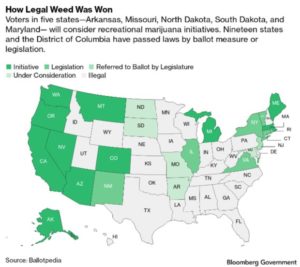News Provided by Bloomberg Government
Maybe call it the low-hanging dope principle: It has become tougher for marijuana legalization backers to get their proposals in front of voters, either because the states where cannabis is still illegal have more qualification requirements, unsympathetic public officials, or both.
As NORML’s state policy manager Jax James put it: “We’re getting into the more meaty part of the work.”
And meaty can mean expensive.
A recreational legalization measure made it onto the November ballot in Missouri (Amendment 3) as campaigners raised over $3.7 million, according to the campaign finance tracking website OpenSecrets.org.
Adjusted for inflation, the per-signature cost worked out to being almost seven times higher than the $2.46 per name spent in Colorado in 2012, and three times what California advocates spent to gather weed legalization signatures in 2016, according to Ballotpedia.
The other cannabis questions on this year’s ballot:
Arkansas’s (Issue 4) seeks to let 21-year-olds buy marijuana and allow the state to collect a 10% tax on it. That state’s Supreme Court ordered it to go before voters after the board of election commissioners tried to keep it off.
The North Dakota initiative lets adults 21 and older own an ounce of the drug or three plants.
South Dakotans will again vote on legalizing cannabis and related paraphernalia this fall after the successful 2020 initiative was thrown out in court (Initiated Measure 27).
Marylanders will vote on a proposed constitutional amendment (Question 4) to legalize marijuana and direct the Legislature to pass further legislation to create a regulated market.
Meanwhile, bureaucracy worked against initiative proponents in two states.

The campaign for Oklahoma’s legalization measure (State Question 820) missed an Aug. 26 ballot-preparation deadline due to an unusually slow signature count, making it ineligible for the 2022 ballot, the state Supreme Court ruled last week.
And backers of Nebraska’s medical marijuana proposal say they missed a 10-day window to challenge the initiative’s signature count because it took too long. —Tiffany Stecker
H/T: Bloomberg Government


